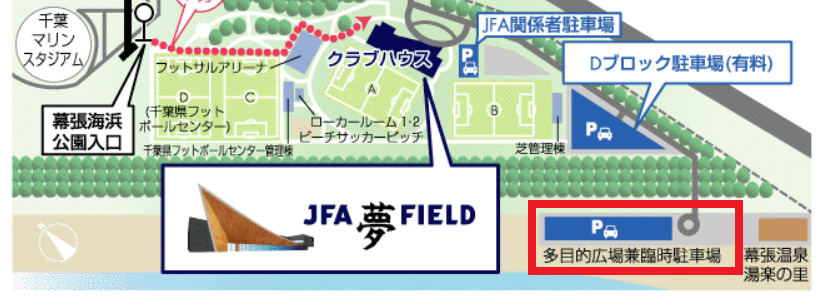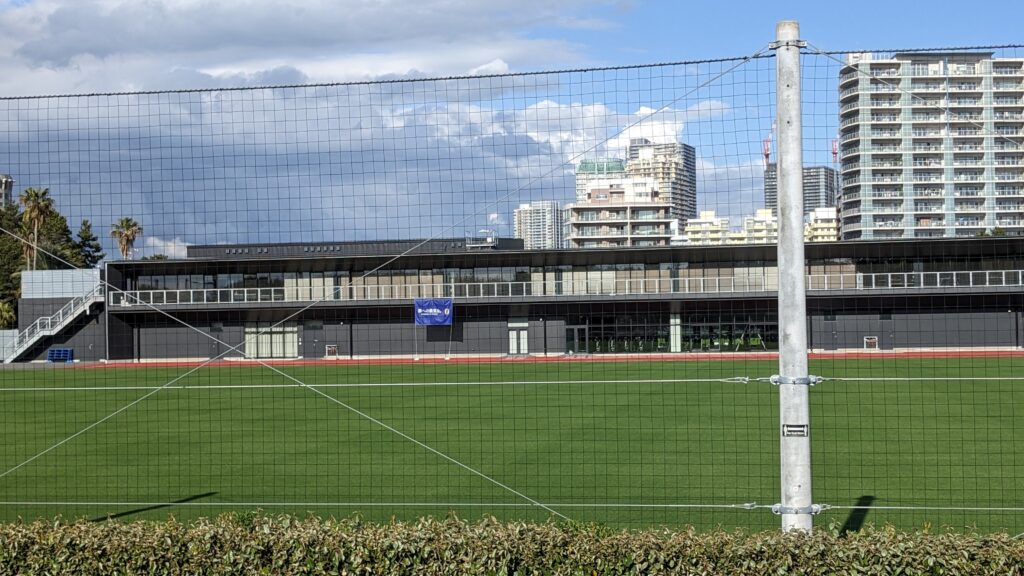Prince Takamado Memorial JFA Yume Field (Dream Field)
JFA Dream Field is a Japan Football Association facility located in Mihama-ku, Chiba City, also known as Makuhari. It has several pitches, a sand field for beach soccer, and an indoor arena for futsal. The natural grass pitch is often used for training camps for the Japanese national men’s and women’s soccer teams. The artificial turf pitches are available for rent to the public.
Anyone can drop by, and when I visited, many people from the neighborhood were walking around. According to one of the walkers, when the Japanese national men’s team was in training camp, the fence was covered with a curtain to prevent people from watching the training.
Nearby is Chiba Marine Stadium (ZOZO Marine Stadium), home of the Chiba Lotte Marines.
There is a hot spring facility called Makuhari Onsen Yuraku no Sato, and people can enjoy the hot spring if they pay an admission fee. There seems to be an open-air bath where they can see the sea.
Why did I visit?
The soccer team that my son belongs to decided to practice at pitch D here, so I was taking him there. The team usually practices at another place, but unfortunately, they couldn’t use the place. They rented this place temporarily to practice.
For some reason, pitch D is managed by the Chiba Football Association, and the reservation procedure seems to be different from other pitches.
Block D parking lot
By train, it is about a 15-minute walk from Kaihinmakuhari Station on the JR Keiyo Line.

I decided to go by car this time, but the issue is the parking lot.
The access page on the Yumef Field website says, “Please use the block D parking lot (600 yen per time)”. I was a little worried that it might be full when I get there. I decided to go with Plan B, thinking that if I go toward the station I would be able to park at a coin parking or a commercial facility somewhere.

Multipurpose Space and Temporary Parking Lot
When I drove up to visit there, I found that the block D parking lot was full. Since it is just a coin-operated parking lot, anyone can park their car there even if they do not use the Yume Field. In fact, on this day, the parking lot was full even though almost no one was using the Yume Field.
Judging from the atmosphere, it seemed unlikely that any cars in the parking lot would be leaving soon. I pulled over to the side of the road to look for a nearby coin-operated parking lot with my smartphone, when a man who happened to be nearby kindly pointed me toward the back of the road. He said that there was another parking lot in the back. I drove on and found another parking lot. That was the Multipurpose Space and Temporary Parking Lot.
The fee is also 600 yen per visit. There is an attendant at the entrance, and we hand over the cash when entering. It looked as if the lot was full, but there were vacancies. I handed 600 yen to the attendant and entered the lot.
Since the vacant area is spread out along the seashore, some people may park their cars there and play or take a walk there.
How to get from the Temporay Parking Lot to Yume Field
As for how to get from this temporary parking lot to the pitch of Yume Field, it’s a long way to go back to the road the car came through. There are some trails or open areas that you can cross through the woods. You can follow the side of the vacant lot or the embankment, and when you come across a trail or open area in the woods, you can pass through it and go out to the side of the Yume Field ground. (For your reference, I drew a light blue line in the photo below.)

Why was the parking lot crowded?
On this day, the Chiba Lotte Marines game was held at Chiba Marine Stadium, and people watching the baseball game parked their cars in this parking lot. When I returned to the parking lot from the Yume Field, I saw people wearing uniforms of their favorite players walking from Chiba Marine Stadium to the parking lot. We might need to be careful when there is a baseball game and the times overlap.
Otheres
Here are some pictures I took while I was there.
A part of the building is a general customer area, and I was able to enter.


Japanese national soccer players’ autographed balls are displayed. You can also see the autograph of Mr. Moriyasu, the manager of the Japan men’s team.

I didn’t take any pictures, but on the floor in the building, you can see the lines of the goal area or the penalty area, the point where the ball is placed for PK, and the line of the center circle, so you can feel their size.
This is pitch A which the Japanese national team uses for practice.


There is also a sand beach soccer ground.



